Danes in Denmark
Instead of talking about what we have seen and what we have been doing I thought that I would dedicate this blog to discussing the people of Denmark. Much of the beginning of this article has been stolen from various write-ups on the web. I fully admit to plagiarizing content that is hopefully in the public domain.
In an earlier article, I mentioned the Danish word hygge, pronounced “hoo-ga” which originated from a Norwegian word meaning “wellbeing”. Hygge is really hard to translate as it is more an attitude to life rather than any single item. Danes credit hygge with contributing heavily to Denmark’s ranking as the world’s happiest country. Hygge is often translated to “cosiness” or the enjoyment of good, everyday things in life.
In line with hygge are the 10 rules of Jante also written about previously. These rules suggest that Danes are happy because they aspire to be average. Dupuis, a researcher, argues that the benefits of the law are born out by happiness research. By following the 10 rules, “You’ll probably set your sights on living a very average life. With such a mentality, you’re likely to be quite content when life hands you very average things,” she writes. “On the other hand, if life happens to hand you something above and beyond average, you’ll likely feel pleasantly surprised, and in most cases, pretty darn happy.”
The newspaper columnist Annegrethe Rasmussen, sparked a recent Jante Law debate when she wrote about her experiences of coming home from Washington, D.C., where she lives, and telling her friends about her son’s performance at school. “I said, ‘He’s doing really well, he is number one in his class.’ And the table went silent.” Though she is Danish, and so should have known better, she realized immediately that she had breached the code. “If I had said he was great at role-playing or drawing it would have been fine, but it was totally wrong to boast about academic achievement.”
This striving for “average” seems very foreign to the North American mentality but no-one has ever listed the United States or Canada as the happiest country in the world. Maybe there is something to it. Out of all the Danes that we have met and visited with so far there has only been one that seemed to be living his life with the American fast track mentality. This man, who had a family, lived 220 km from where he worked. He drove in and out to Copenhagen every day. When he got home at 7pm at night he would work for 4 or 5 hours building a house to sell. This is the third house he has built. It doesn’t sound like that schedule leaves a lot of time of hygge or happiness. Multiple couples have told us that they don’t mind high taxation at all if it protects the sick and the elderly and helps educate their children. It doesn’t appear that they are just saying this, I really think they mean it. They aren’t looking to get rich. They know that they will be protected in their retirement and believe in fully enjoying their “average” life.
You can read more about the rules of Jante at https://qz.com/794740/the-happiness-of-the-danes-can-easily-be-explained-by-10-cultural-rules/ .
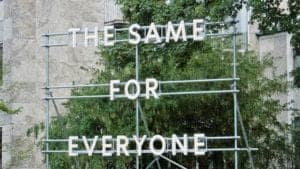 At one marina Mike and I saw a large scaffold with a sign in lights that said “THE SAME FOR EVERYONE”. Mike recognized its significance based on Danish attitude before I did. We then saw the same sign in a second town and looked it up. According to the internet there are ten installations of this same sign which is intended to bring your attention to one of the most treasured of Danish values, namely ‘equality for all’. This whole idea is pervasive everywhere. Denmark has one of the smaller differences between the average salary of a CEO and the salary of the workers. CEOs in Norway and Denmark are paid considerably less than their European and American counterparts but seem quite content with what they have.
At one marina Mike and I saw a large scaffold with a sign in lights that said “THE SAME FOR EVERYONE”. Mike recognized its significance based on Danish attitude before I did. We then saw the same sign in a second town and looked it up. According to the internet there are ten installations of this same sign which is intended to bring your attention to one of the most treasured of Danish values, namely ‘equality for all’. This whole idea is pervasive everywhere. Denmark has one of the smaller differences between the average salary of a CEO and the salary of the workers. CEOs in Norway and Denmark are paid considerably less than their European and American counterparts but seem quite content with what they have.
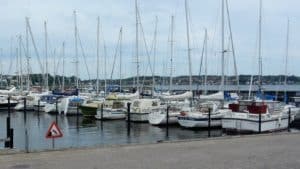 Going into one marina was a sign with rules about how you should park etc. Since it was in Danish I couldn’t read what I was supposed to do but the sign ended with “Ha’ en god dag!”. That I could figure out. It reminded me of those quizzes where you are showed a sentence with no vowels and yet you can usually read the whole thing. Many signs include comments about welcome, thank-you, have a nice day etc. Again, it all contributes to a nicer atmosphere than just a sign saying don’t do something. Enlarge and zoom in on this picture. Have a look at the sign at the edge of the parking lot next to where we camped. I thought it was quite interesting. Note that there is no railing, curbs or anything for the cars – just the sign ?.
Going into one marina was a sign with rules about how you should park etc. Since it was in Danish I couldn’t read what I was supposed to do but the sign ended with “Ha’ en god dag!”. That I could figure out. It reminded me of those quizzes where you are showed a sentence with no vowels and yet you can usually read the whole thing. Many signs include comments about welcome, thank-you, have a nice day etc. Again, it all contributes to a nicer atmosphere than just a sign saying don’t do something. Enlarge and zoom in on this picture. Have a look at the sign at the edge of the parking lot next to where we camped. I thought it was quite interesting. Note that there is no railing, curbs or anything for the cars – just the sign ?.
Continuing on with language, you often see a heading in a store window or on a menu in English but then the entire description is in Danish. It is very unusual. The waiters and waitresses in one burger restaurant where wearing a hat that said “grillen” which the Danes use for burgers while their t-shirts said “Made from beef, cheese and love” in English. It is a strange mixture. Occasionally words that you recognize don’t necessarily mean what you think. For example the word menu can be used as we use it when it is written as an English word. In Danish it is used to mean combo so if you order a hamburger menu you get fries and a drink added in. We ate in “Farmor’s Café”. We assumed this meant “Farmers Café” but it turned out to mean “Grandmother’s Café”. Earlier in the trip we were in the town Tønder and I asked a couple what town we were in, wanting to hear how it was pronounced. By now I knew that the ø is pronounced “oo”. Well Mike and I were convinced that they gave us some other town name. I have no idea how one gets to Tønder from what we heard. Although we might be able to figure out many written words like “Ha’ en god dag!” we can never understand any of them when they are spoken. Phonetically pronouncing words is done very, very differently in Danish. Somewhat related is something that has annoyed me for years and that I don’t understand which is why we had to rename towns, cities and countries that were spelt using the same alphabetic and a familiar grouping of letters. I fully understand having to change Russian or Chinese names but if Lisboa is good enough for the Portuguese why do we call it Lisbon. And if the Italians wanted Firenze why do we say Florence. Why I am in Denmark right now when the people who know best spell it Danmark? I just think that is wrong.
A local TV station put out the video below that was watched by many, many Danes and was then translated into English. It is intended to show how people as a whole are more similar than they are different https://www.youtube.com/watch?v=jD8tjhVO1Tc .
One museum that we visited said that nearly all the towns in existence today were also in existence in the 1500s. This is true in Denmark and possible most of Europe. How different is that from North America! We visited the town of Randers which had the oldest pedestrian mall in Denmark. Every town of any size has had pedestrian malls lined with retail stores, pharmacies, churches, cafés, pubs, nice squares and more. These pedestrian malls work really well for a population that is used to walking and biking. In North America we are well known to be wedded to our cars. I don’t see the downtown retail core of a city in Canada being changed to pedestrian only without a major change to our attitudes. In Toronto retailers think that they lose money when streets are designated pedestrian, in Denmark the retailer does great as the pedestrian areas are the heart of the city.
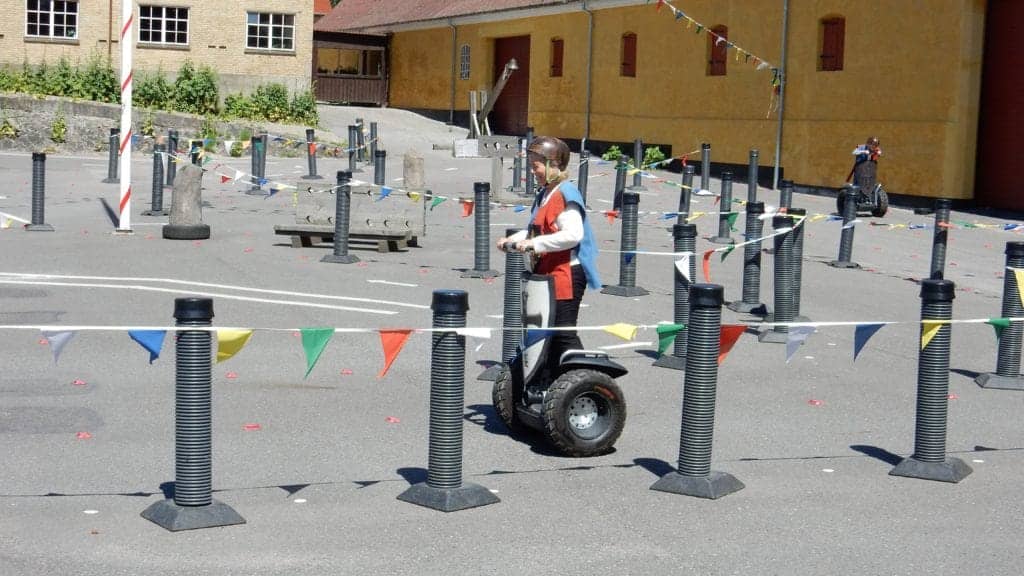
The last three places we camped were all marinas but where they ever different. I wish we had started this trend earlier. At the first marina we were the only camper there. At the second marina, in Aarhus the second largest city in Denmark, we arrived near the end of an in-water boat show and festival. It was packed. They had cars parked in the camping area. It was really too tight for us with our 37 foot camper towing a Lincoln but Mike managed. We squished in between two boats that were being worked on and had another camper at 90 degrees to us. This setup wasn’t great but the marina was superb. There were restaurants, creperies and more. A brass band played one evening. You can walk out to any of the boats in all of the marinas we have been at so far. There is none of the security that you see in Canada where you can’t get onto the boat docks unless your boat is there. The third marina was also lovely. It was a good size but not as big as Aarhus and nor was it as crowded. There were probably 6 or 8 campers there. Again you could wander around the boats to your hearts content. That is the one thing that we do miss in the camper, being out on the water. The temperature has been too cold and the ocean is salt-water with waves which don’t make for a great place for our little inflatable boat. The wind here is great for sailors and so are the sunlight hours. It is still quite light at 10:30 at night and you can easily wander around. The sun is up before 4 AM. We have blackout blinds on all our windows but we have a lot of light coming in at all hours from our skylights and ceiling fans.
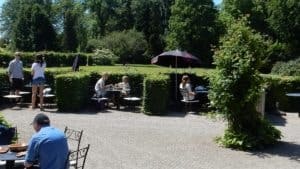
For a country so bicycle oriented we have been very surprised to see that none of the bicycle have mirrors. Mike and I both use our side view mirror a lot. Helmets are also optional and not worn very often over here. Of course, the roads and the cars and their drivers are much more bicycle friendly which does help.
Something that you don’t see much of at home but is quite common here are the robo lawn mowers. They are just like the circular robo vacuum cleaners that we have except that they cut the lawn. Somehow they know where to stop and not go down cliffs or onto driveways.
A Swiss couple that we spent quite a bit of time with were unhappy that they couldn’t take their dog into retail stores and restaurants in Denmark like you can in much of Europe. As a Canadian it surprises us every time we see a dog in a restaurant or store. Not only are we learning about Denmark on this portion of our trip but we are learning about other countries as well. The campers are from a variety of European countries. The Swiss couple was telling us that in Switzerland the same tuition is charged for university whether you are Swiss or are from outside the country and that the tuition is extremely low. I didn’t really believe this so I looked it up. ETH Zurich is possibly the top rated university in Europe and in the top 10 world wide. Their tuition for foreign students is the same as for local students approx. $1,200 USD per year. The rates at EPFL (near Geneva), Switzerland’s second highest rated university are basically the same. There are extra costs for books and a high cost of living but I found this very interesting.
Overall Mike and I are learning a lot. This is a much more interesting way to meet and learn about people than simply reading about them or going to school. We are looking for to continuing to expand our horizons over the next few years.

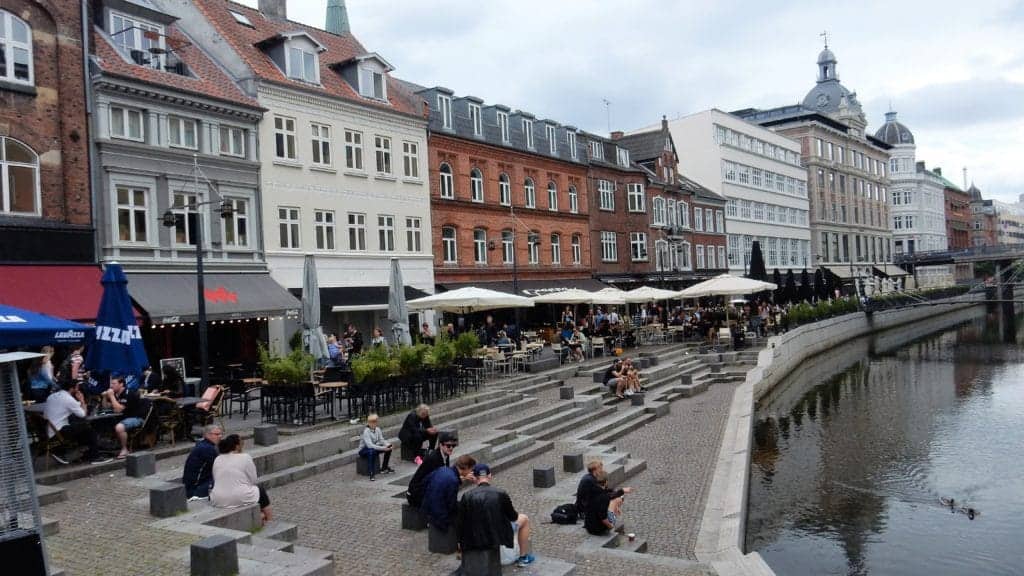
Leave a Reply